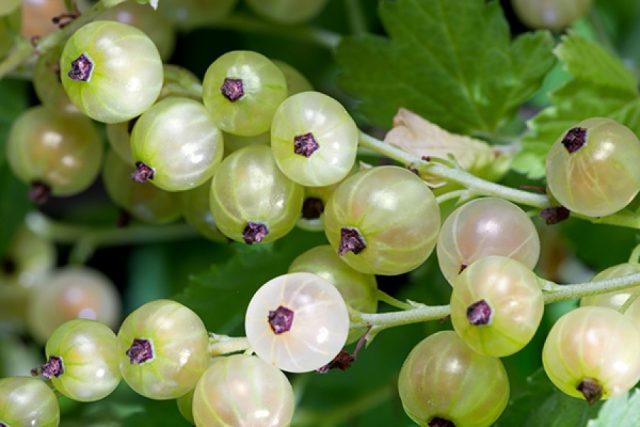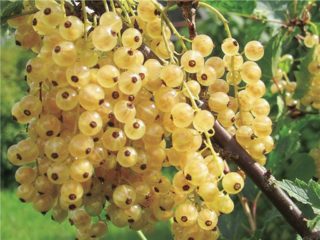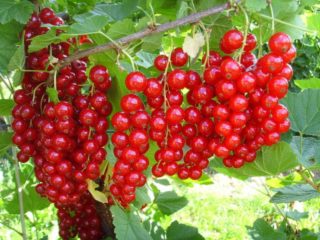Content
White currants are not as popular as red and black ones. But in terms of benefits and taste, white-fruited varieties are in no way inferior. The proof can be the Smolyaninovskaya currant, which belongs to a mid-season unpretentious hybrid.

Currant Smolyaninovskaya is adapted to difficult climatic conditions
History of selection
The Smolyaninovskaya currant variety was obtained by intervarietal crossing. Breeders from the All-Russian Breeding Technical Institute of Horticulture and Nursery Science N.K. Smolyaninova, in whose honor the hybrid received its name, and V.M. Litvinova, worked on the breeding.
The currant hybrid was sent for variety testing in 1985. It entered the state register in 1995 and was zoned for cultivation in the Central and Volga-Vyatka regions.
Description of white currant Smolyaninovskaya
White-fruited currant is one of the rare berry bushes.But having studied the description of the Smolyaninovskaya variety, we can say with confidence that this culture is in no way inferior to similar species with red and black berries.
Bush
The white Smolyaninovskaya bush can be classified as tall, since it can reach a height of up to 1.5 m. It is compact, spreading with branches evenly developed along the entire length. Annual shoots are covered with a glossy light green skin, while perennial and skeletal branches of the plant generally have denser, light brown bark.
The leaf blades on the shoots are located almost horizontally. They are palmate-lobed in shape, the surface is slightly wrinkled, with a slight shine, and the lower part is slightly pubescent.
During the flowering period, large pink flowers of 10-12 pieces appear on the bush, which form a dense brush.
Berries
At the end of flowering, fruits begin to form. They are not very close to each other (one bunch can contain up to 10-15 berries). The fruits are large, their average weight is 0.6-0.9 g, round or slightly oval in shape, white in color, with slight transparency. The berries are covered with thick skin, their pulp is juicy. There are a small number of seeds and, unlike other varieties, they are soft.
Ripe fruits can be stored on the bush for a long time without overripening. And after picking, they also do not lose their quality for a long time, which allows the berries to be transported over long distances.

The berries are held firmly on the stalks and do not fall off
Characteristics of the variety
In addition to the unusual white-cream color of the fruit, Smolyaninovskaya currants are also distinguished by other characteristics.It is worth highlighting its taste, ease of care and good resistance to both weather conditions and various diseases.
Taste qualities
The taste qualities of Smolyaninovskaya currants are pronounced. The berry has a sweetish-sour taste, and is very pleasant to eat fresh. The tasting score of the fruit is 4.7 points.
In application, Smolyaninovskaya currant is universal. It is eaten fresh and processed in the form of preserves and jam. It is also suitable for preparing low-alcohol drinks, wine, compote and fruit juice.
The predominant sourness of the berry is explained by the high content of vitamin C (up to 32%). In addition, currants are rich in other vitamins. The pulp contains up to 7% sugars and up to 2% titratable acid.
Productivity
The Smolyaninovskaya currant hybrid is a mid-season variety. The productivity of the bush is noted as high. You can get up to 6 kg from one plant. When grown for industrial purposes, the yield can reach up to 11 tons per bush.
Frost resistance
Smolyaninovskaya currant was bred specifically for cultivation in the Central region, so the bush is not afraid of frost. Also, due to its well-developed root system, the plant can easily tolerate dry weather.
Disease resistance
The hybrid's immunity is high. Currants have complex resistance to fungal infections. With proper care, the shrub rarely gets sick and is susceptible to attacks by insect pests.
Advantages and disadvantages
The beautiful and tasty fruits of the Smolyaninovskaya currant are only part of the positive qualities of the berry bush.The plant also has other advantages that knowledgeable gardeners highlight.

One of the features of Smolyaninskaya currant is self-fertility.
Pros:
- ease of care;
- high resistance to low temperatures and drought;
- stable harvest;
- excellent taste;
- attractive appearance of berries;
- good preservation of berries on the bush after ripening and increased shelf life after picking;
- transportability of the crop over long distances;
- persistent immunity.
Minuses:
- a fast-growing bush tends to thicken;
- branches begin to sag towards the ground with age;
- low resistance to kidney mites and moths.
How to plant
The algorithm for planting a currant bush of the Smolyaninovskaya variety is not much different from similar berry bushes.
Seedlings are usually planted in the spring, but autumn planting is also acceptable. It is advisable to select a location with loamy or sandy loam soil. The soil should be loose and low acid.
Before planting, the soil is dug up and fertilized. Organic mixtures are used as fertilizing, which are added to a previously prepared hole. The planting hole is prepared in advance; it is dug to a depth of about 40 cm and a diameter of up to half a meter.
River sand and drainage material (crushed stone, pebbles) are poured into the bottom of the pit. Make a mound of soil on top with a layer of up to 10 cm. Carefully place the seedling in the hole, straightening its root system. The roots are covered with fertile soil and lightly compacted.
The last step is watering. After planting the seedling, the soil around it is well moistened, using about 10 liters of warm water.
Features of care
Caring for currants of the Smolyaninovskaya variety is practically no different from caring for plants of any other berry-shrub variety. During the growing season, the crop requires watering, fertilizing, pruning and proper preparation for winter.
Since currants are considered a moisture-loving plant, the bush must be watered regularly. Use at least 15 liters for irrigation per bush. As winter approaches, watering is reduced.
To get a good harvest, you should feed Smolyaninovskaya white currant at least three times a season. In the spring, after awakening, the shrub needs nitrogen-containing compounds, but during the period of flowering and berry formation it is better to fertilize it with complex mixtures or potassium-phosphorus components.
The Smolyaninovskaya variety is characterized by rapid growth, so the shrub needs timely pruning. It is carried out in spring and autumn. In the first case, it is necessary for sanitary purposes after winter; in the second, old shoots are removed to form a crown.

Pruning helps increase shrub productivity
To prepare for winter, the tree trunk circle is mulched in the fall (if the winters are mild and not frosty). If there is a risk of the temperature dropping below -20 ºC, then it is advisable to cover the shrub with agrofibre.
Conclusion
Currant Smolyaninovskaya is a hybrid of white-fruited berries that is well adapted to different climatic conditions. It can be grown in almost any region. The berries ripen in the second half of summer, but they do not need to be quickly picked after ripening, as they are not subject to shedding.
Reviews from gardeners about white currant Smolyaninovskaya








